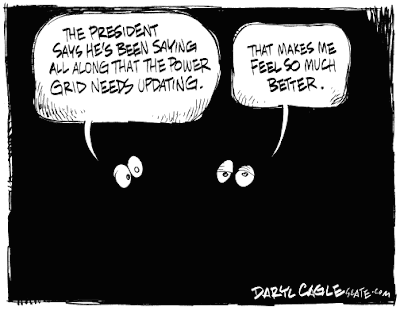Let there be light
 It’s raining, It’s Pouring. This old man was snoring. I was fortunate that the Superstorm Sandy had
nary an impact on me – other than a deluge while walking the dogs. (That happened in St. Paul too, but that soaking came with a sound
and light show.) Sandy’s devastation has
been significant – and the most telling impact is in how people prepared. Some got water, prepped food, put out sand
bags, etc. Others, like me, went to
great efforts to make sure that the laptop, the phone and the Kindle were
charged. I even have a hand crank gizmo
that I can wind up to generate a charge for a device.
It’s raining, It’s Pouring. This old man was snoring. I was fortunate that the Superstorm Sandy had
nary an impact on me – other than a deluge while walking the dogs. (That happened in St. Paul too, but that soaking came with a sound
and light show.) Sandy’s devastation has
been significant – and the most telling impact is in how people prepared. Some got water, prepped food, put out sand
bags, etc. Others, like me, went to
great efforts to make sure that the laptop, the phone and the Kindle were
charged. I even have a hand crank gizmo
that I can wind up to generate a charge for a device.
Approx. 8.2 million households went dark during the height
of the storm – and huge numbers of people won’t see power return for days or
even weeks. Hollywood has kept us
entertained over the years imagining a world without electricity. Reality is
the scariest storyline of all.
The U.S. electric grid is described as a “complex matrix of
transmission and distribution lines.”
The U.S. Energy Administration
actually has a simple map: there are 10
geographic grid distributors. It’s
rather unnerving how simple it would be to disable connectivity for the country
– a handful of incidents and the U.S. is plunged into another age. Everything we do is reliant on electricity –
not just our devices and obvious things like lights – but pumping gas, flushing
toilets and doing laundry. That Americans are so reliant on a centralized source for power is counterintuitive to the idea of rugged individualism.
Having a centralized power grid allows for certain
efficiencies, but also contains dangers as well. In September 2011
5+ million in the Southwest were without power due to an equipment issue. In India this July half the country went
dark. Disabling the handful of nexus
points in the U.S. system would be debilitating.
What would a private grid of networks look like? It would localize the power consumption and
generation so that if something happened in one state, dozens of other states wouldn’t
be affected. It would add a huge amount
of available power for purchase – the ultimate way to further reduce cost since
it’s the essence of a free market economy.
It’d be cumbersome and prone to problems. Regulation would have to be streamlined, but
not eliminated. Democracy is messy and
so would having an electric grid that reflected it. The plus is that there would be more power
and it would be cheaper.
Fixing the electric grid is a national security issue. Imagine what California would be like if then
Governor Gray and his successor Arnold Schwarzenegger had put the huge amounts
of capital (political and economic) into solar instead of building additional
power stations in the state after the Enron fiasco. It doesn’t make sense for government to fund
the building of private power stations – since that decision had already been
made and it was going to expend that money anyway – what would the Golden state
be like today if millions of people had received rebates to put solar on their
houses? There’d be hundreds of thousands of power generating plants – even
giving back to the grid. When the next
natural disaster occurred the entire region wouldn’t be impacted.



Comments
Post a Comment